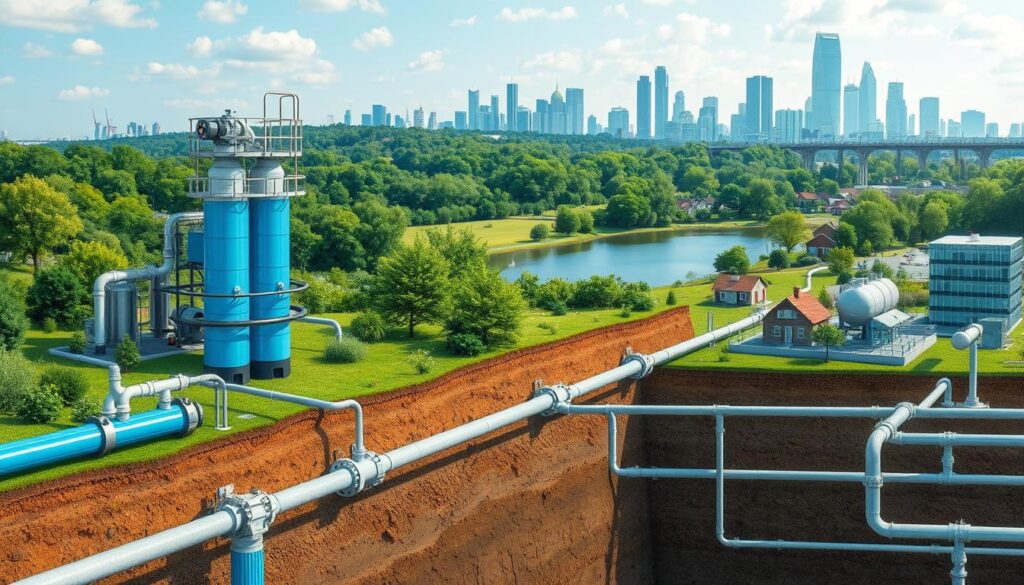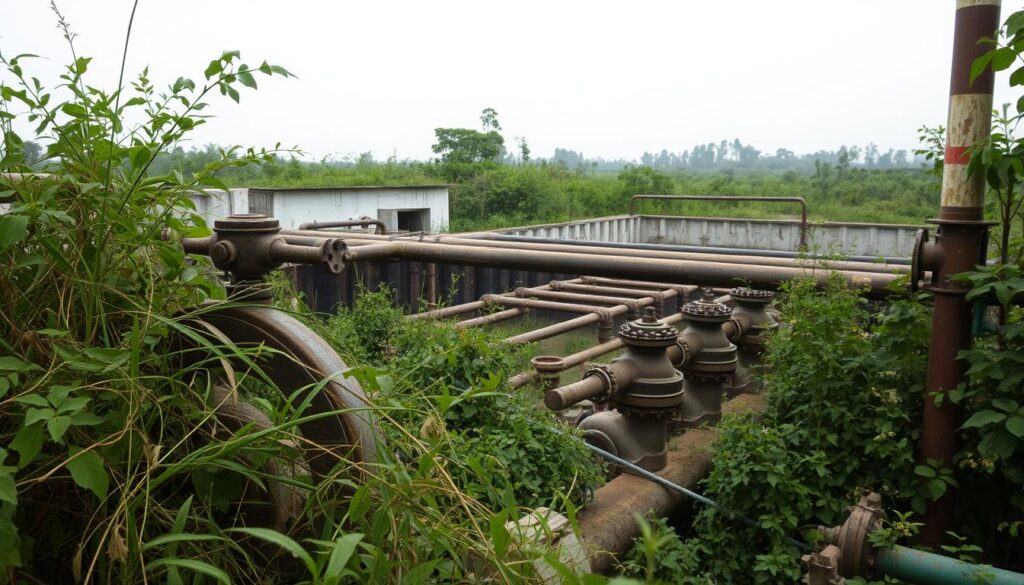Can our aging water infrastructure support the demands of a growing population and the challenges posed by climate change? As communities worldwide face the pressing issue of ensuring reliable access to clean drinking water and sanitation services, the need for effective asset management strategies becomes increasingly evident.
Managing water resource projects, such as dams and water treatment plants, is crucial for maintaining the integrity of our water infrastructure. By optimizing asset management practices, water utilities can enhance service delivery, reduce costs, and mitigate the risks associated with aging infrastructure.
Key Takeaways
- Efficient asset management is crucial for reliable water services.
- Aging infrastructure poses significant challenges to water utilities.
- Optimizing asset management practices can reduce costs and enhance service delivery.
- Effective management of water resource projects is vital for maintaining infrastructure integrity.
- Climate change and population growth increase pressure on water infrastructure.
Understanding Water Infrastructure Asset Management
Water infrastructure asset management involves a systematic approach to managing physical assets to achieve organizational objectives. It encompasses assessing asset condition, performance, and criticality to identify areas for improvement.
Definition and Importance
Asset management is defined as a comprehensive process that includes the identification, assessment, and prioritization of assets, followed by the implementation of maintenance and replacement strategies. The importance of water infrastructure asset management lies in its ability to ensure the reliability, sustainability, and safety of water supply systems.
Efficient asset management enables utilities to optimize their resources, reduce operational costs, and improve customer satisfaction. By adopting a proactive approach to asset management, utilities can mitigate risks associated with asset failures, regulatory non-compliance, and environmental impacts.
Key Components of Asset Management
The key components of asset management include:
- Asset identification and inventory
- Condition assessment and monitoring
- Risk assessment and prioritization
- Maintenance and replacement strategies
- Performance measurement and reporting
These components work together to ensure that assets are managed effectively throughout their lifecycle.
| Component | Description | Benefits |
|---|---|---|
| Asset Identification and Inventory | Creating a comprehensive inventory of assets | Improved asset visibility and control |
| Condition Assessment and Monitoring | Regularly assessing the condition of assets | Early detection of potential failures |
| Risk Assessment and Prioritization | Evaluating the criticality of assets and associated risks | Prioritized maintenance and resource allocation |
Regulatory Frameworks Impacting Water Infrastructure
Regulatory frameworks play a crucial role in shaping water infrastructure asset management practices. Utilities must comply with various regulations and standards related to water quality, environmental protection, and public health.
Compliance with regulatory requirements not only ensures the safety and quality of water services but also helps utilities avoid potential fines and reputational damage.
Current State of Water Infrastructure in the U.S.

As the backbone of public health and economic vitality, the current state of U.S. water infrastructure demands immediate attention. The nation’s water infrastructure is a complex network of pipes, treatment plants, and distribution systems that are crucial for delivering safe drinking water and managing wastewater.
Aging Infrastructure Challenges
The average age of fixed assets in operation is around 24 years, highlighting the need for effective asset management strategies to extend asset lifespans and improve service delivery. Aging infrastructure poses significant challenges, including increased maintenance costs, higher risk of failures, and decreased efficiency.
Infrastructure asset monitoring plays a critical role in identifying potential issues before they become major problems. By leveraging advanced technologies, utilities can better manage their assets and reduce the likelihood of catastrophic failures.
Recent Developments in Infrastructure Spending
There have been recent developments in infrastructure spending that aim to address the challenges posed by aging water infrastructure. The U.S. government has proposed various initiatives to increase funding for water infrastructure projects, recognizing the importance of water system optimization in ensuring the long-term sustainability of the nation’s water resources.
“Investing in our nation’s water infrastructure is crucial for public health, economic growth, and environmental sustainability.” –
Regional Disparities in Asset Quality
Regional disparities in asset quality are a significant concern, with some areas having more modern and well-maintained infrastructure, while others struggle with outdated systems. A comprehensive analysis of the current state of water infrastructure reveals that regional differences in asset quality are influenced by factors such as funding availability, regulatory frameworks, and local priorities.
| Region | Average Asset Age | Infrastructure Condition |
|---|---|---|
| Northeast | 30 years | Fair |
| South | 20 years | Good |
| West | 25 years | Fair |
Understanding these regional disparities is essential for developing targeted strategies to improve the overall quality of water infrastructure across the U.S.
The Role of Technology in Asset Management
Advancements in technology are playing a crucial role in modernizing water infrastructure asset management practices. The integration of advanced technologies is enabling utilities to optimize asset performance, reduce costs, and improve service delivery. As the water industry continues to evolve, the adoption of innovative technologies is becoming increasingly vital for effective utility asset management.
IoT and Smart Sensors for Monitoring
The Internet of Things (IoT) and smart sensors are revolutionizing the way utilities monitor their assets. By deploying IoT devices and smart sensors, utilities can collect real-time data on asset condition, performance, and environmental factors. This data is crucial for identifying potential issues before they become major problems, thereby enhancing the reliability and efficiency of water infrastructure.
For instance, smart sensors can monitor water pressure, flow rates, and quality in real-time, allowing for immediate response to anomalies. This proactive approach to asset management helps in reducing the likelihood of failures and extends the lifespan of critical infrastructure.
Data Analytics for Predictive Maintenance
Data analytics is another key technology driving improvements in water infrastructure planning. By analyzing data collected from IoT devices and other sources, utilities can predict when maintenance is required, reducing the likelihood of unexpected failures. Predictive maintenance enables utilities to schedule repairs during off-peak periods, minimizing disruptions to service and optimizing resource allocation.
Advanced data analytics tools can also help identify trends and patterns in asset performance, enabling utilities to make informed decisions about investments in infrastructure. For more insights on emerging technologies in asset management, visit this resource.
Software Solutions for Asset Management
Software solutions are also playing a vital role in modern asset management practices. Comprehensive asset management software enables utilities to track asset condition, maintenance history, and performance metrics in a centralized system. This facilitates better decision-making and more efficient management of water infrastructure assets.
These software solutions often include features such as work order management, inventory control, and reporting tools, which help streamline operations and improve overall asset reliability. By leveraging these technologies, utilities can achieve significant improvements in their asset management practices, leading to more resilient and sustainable water infrastructure.
Best Practices for Effective Asset Management

To achieve optimal asset management, water infrastructure operators must adopt best practices that ensure the longevity and efficiency of their assets. Effective asset management involves a combination of strategies that help maintain and improve the overall performance of water infrastructure.
Regular Assessment and Evaluation
Regular assessment and evaluation are critical components of effective asset management. This involves conducting asset performance analysis to identify areas of improvement and implementing asset depreciation tracking to monitor the condition of assets over time.
- Conducting regular inspections to identify potential issues before they become major problems.
- Using data analytics to track asset performance and make informed decisions.
- Implementing a maintenance schedule to ensure that assets are properly maintained.
Stakeholder Engagement and Communication
Stakeholder engagement and communication are essential for effective asset management. This involves working closely with stakeholders to understand their needs and expectations, and communicating asset management plans and progress to relevant parties.
- Identifying key stakeholders and their roles in the asset management process.
- Developing a communication plan to ensure that stakeholders are informed and engaged.
- Using public outreach and education programs to raise awareness about asset management practices.
Comprehensive Asset Inventory
Maintaining a comprehensive asset inventory is vital for effective asset management. This involves creating a detailed record of all assets, including their condition, location, and maintenance history.
- Developing a centralized database to store asset information.
- Conducting regular updates to ensure that the inventory remains accurate and up-to-date.
- Using asset inventory data to inform maintenance and replacement decisions.
By implementing these best practices, water infrastructure operators can ensure that their assets are managed effectively, efficiently, and sustainably.
Developing a Strategic Asset Management Plan
A strategic asset management plan serves as the backbone of water infrastructure management, guiding decision-making and resource allocation. This plan is essential for ensuring that water infrastructure assets are managed effectively and efficiently throughout their lifecycle.
Identifying Goals and Objectives
The first step in developing a strategic asset management plan is to identify clear goals and objectives. These goals should align with the overall mission of the organization and address specific needs related to water infrastructure asset management. Key considerations include improving asset reliability, reducing maintenance costs, and enhancing customer satisfaction.
To achieve these goals, organizations should conduct a thorough analysis of their current asset management practices. This involves assessing the condition of existing assets, evaluating current maintenance practices, and identifying areas for improvement.
Risk Assessment and Mitigation Strategies
A critical component of a strategic asset management plan is a comprehensive risk assessment. This involves identifying potential risks associated with asset failure, such as operational disruptions, financial losses, and environmental impacts. Once risks are identified, organizations can develop mitigation strategies to minimize their impact.
Effective risk mitigation may involve implementing predictive maintenance practices, investing in asset redundancy, or developing emergency response plans. By proactively managing risks, organizations can reduce the likelihood of asset failures and ensure continuity of service.
Setting Performance Metrics
To measure the success of a strategic asset management plan, organizations must establish clear performance metrics. These metrics should be aligned with the identified goals and objectives and provide a quantifiable measure of progress. Examples of performance metrics include asset availability, maintenance cost savings, and customer satisfaction ratings.
Regular monitoring and reporting of these metrics are crucial for evaluating the effectiveness of the asset management plan and making necessary adjustments. A well-designed performance measurement system enables organizations to make data-driven decisions and drive continuous improvement in asset management practices.
| Performance Metric | Description | Target Value |
|---|---|---|
| Asset Availability | Percentage of assets available for operation | 95% |
| Maintenance Cost Savings | Reduction in maintenance costs compared to baseline | 15% |
| Customer Satisfaction | Ratings based on customer surveys | 85% |
Funding and Financing Options

Water infrastructure projects require substantial investment, and understanding the available funding options is crucial. Effective water asset management is contingent upon securing adequate financial resources.
Federal and State Funding Sources
Federal and state governments provide various funding sources for water infrastructure projects. These include grants, loans, and other financial assistance programs aimed at supporting water utilities in maintaining and upgrading their infrastructure.
For instance, the Water Infrastructure Finance and Innovation Act program offers loans and guarantees for water infrastructure projects, helping to leverage additional funding from other sources.
| Funding Source | Description | Eligibility |
|---|---|---|
| WIFIA | Loans and guarantees for water infrastructure projects | Water utilities, municipalities |
| State Revolving Funds (SRFs) | Low-interest loans for water infrastructure projects | Water utilities, municipalities, and other eligible entities |
Public-Private Partnerships (PPPs)
Public-Private Partnerships (PPPs) represent a collaborative approach between public agencies and private sector entities to finance and deliver water infrastructure projects. PPPs can offer benefits such as improved efficiency, reduced costs, and enhanced service quality.
“PPPs can be an effective way to deliver water infrastructure projects, bringing together the strengths of both public and private sectors.”
Grant Opportunities for Infrastructure Projects
Grants are another vital funding source for water infrastructure projects. Various government agencies and organizations offer grants to support projects that improve water quality, enhance infrastructure resilience, and promote sustainable water management practices.
Examples include the Environmental Protection Agency’s (EPA) grant programs for water infrastructure projects, which provide funding for projects that address water quality issues and support community development.
By exploring these funding and financing options, water utilities can secure the necessary resources to implement effective water asset management strategies, ensuring the long-term sustainability of their infrastructure.
Training and Capacity Building
Training initiatives play a vital role in enhancing the capabilities of those involved in utility asset management. Effective training and capacity building are essential for ensuring that professionals have the necessary skills and knowledge to manage infrastructure assets efficiently.
Essential Skills for Asset Management Professionals
Asset management professionals require a diverse set of skills, including technical knowledge, data analysis, and project management. Technical skills are crucial for understanding infrastructure asset monitoring systems, while data analysis enables professionals to make informed decisions.
- Understanding of asset management principles
- Proficiency in data analysis tools
- Knowledge of regulatory frameworks
- Project management skills
Workshops and Certification Programs
Workshops and certification programs are vital for providing asset management professionals with the necessary training. These programs help professionals stay updated with the latest technologies and best practices in utility asset management.
| Program | Description | Provider |
|---|---|---|
| Certified Asset Management Professional | A comprehensive certification program covering asset management principles and practices. | Institute of Asset Management |
| Advanced Infrastructure Asset Monitoring | A workshop focusing on the latest techniques and technologies in infrastructure asset monitoring. | Asset Management Association |
Encouraging Knowledge Transfer within Organizations
Encouraging knowledge transfer within organizations is critical for sustaining the benefits of training and capacity building. This can be achieved through mentorship programs, regular training sessions, and the use of knowledge management systems.
By fostering a culture of continuous learning and knowledge sharing, organizations can ensure that their professionals remain equipped to handle the evolving challenges of utility asset management.
Environmental Sustainability in Asset Management

The integration of environmental sustainability into asset management practices is crucial for the long-term viability of water infrastructure. As utilities and municipalities strive to optimize their water systems, they must balance operational efficiency with environmental stewardship.
Green Practices in Asset Management
Incorporating green practices into asset management involves adopting technologies and strategies that minimize environmental impact. This can include using energy-efficient equipment, implementing water-saving technologies, and designing infrastructure that works with natural systems rather than against them.
Key green practices include:
- Utilizing renewable energy sources to power water treatment and distribution systems.
- Implementing green infrastructure, such as green roofs and permeable pavements, to manage stormwater runoff.
- Employing advanced materials and coatings to reduce corrosion and extend the lifespan of assets.
Benefits of Sustainable Asset Management
Sustainable asset management offers numerous benefits, including cost savings, reduced environmental impact, and enhanced community well-being. By optimizing water system performance through asset performance analysis, utilities can reduce energy consumption, lower operational costs, and improve overall system reliability.
“Sustainable water management is not just about conserving water; it’s about ensuring the long-term health of our ecosystems and communities.” – Environmental Expert
Regulatory Incentives for Sustainability
Regulatory bodies are increasingly offering incentives for utilities and municipalities to adopt sustainable practices in asset management. These incentives can include grants, tax credits, and regulatory flexibility for utilities that demonstrate a commitment to environmental sustainability.
Utilities can benefit from:
- Exploring federal and state funding opportunities for green infrastructure projects.
- Participating in voluntary programs that recognize and reward sustainable practices.
- Collaborating with regulatory agencies to develop innovative solutions that meet environmental goals.
By embracing environmental sustainability in asset management, the water sector can not only reduce its environmental footprint but also enhance its resilience and efficiency, ultimately contributing to a more sustainable future.
The Impact of Climate Change on Water Infrastructure
As climate change intensifies, water infrastructure is facing unprecedented challenges that demand innovative solutions. Rising temperatures, changing precipitation patterns, and increased frequency of extreme weather events are all contributing to the strain on existing water systems.
Adapting to Rising Temperatures and Sea Levels
One of the most significant impacts of climate change on water infrastructure is the rise in sea levels and increased temperatures. Coastal areas are particularly vulnerable to sea-level rise, which can lead to saltwater intrusion into freshwater sources and damage to infrastructure. To adapt, water managers must implement strategies such as:
- Upgrading infrastructure to be more resilient to flooding and saltwater corrosion
- Implementing early warning systems for flood events
- Enhancing water treatment processes to handle increased salt levels
Designing Resilient Infrastructure
Designing resilient water infrastructure is critical to withstanding the impacts of climate change. This involves not only constructing new infrastructure with resilience in mind but also retrofitting existing systems. Key considerations include:
- Using materials and designs that can withstand projected climate conditions
- Incorporating green infrastructure to manage stormwater runoff
- Ensuring that infrastructure can adapt to changing water availability
Long-term Planning for Extreme Weather Events
Effective long-term planning for extreme weather events is essential for maintaining the integrity of water infrastructure. This includes:
| Planning Strategy | Description | Benefits |
|---|---|---|
| Risk Assessment | Identifying potential risks and vulnerabilities in the infrastructure | Prioritizing upgrades and repairs |
| Emergency Preparedness | Developing plans and protocols for responding to extreme weather events | Minimizing damage and downtime |
| Asset Depreciation Tracking | Monitoring the condition and value of infrastructure assets over time | Optimizing maintenance and replacement schedules |
By adopting a proactive and resilient approach to water infrastructure planning, utilities can better withstand the challenges posed by climate change, ensuring the continued provision of safe and reliable water services.
Integrating Community Feedback into Asset Management

By engaging local communities, water infrastructure asset management can be made more effective and responsive to public needs. This approach not only fosters a sense of ownership among community members but also ensures that the infrastructure meets the actual needs of the population it serves.
Engaging Local Communities
Engaging local communities is a critical step in integrating community feedback into asset management. This can be achieved through public meetings, surveys, and other forms of outreach. Effective community engagement helps in understanding the concerns and priorities of the community, which can then be incorporated into the asset management plans.
Incorporating Public Input in Planning
Incorporating public input in planning is essential for creating infrastructure that is aligned with community needs. This involves not just collecting feedback but also ensuring that it is acted upon. Transparent communication about how public input is being used can significantly enhance trust between the community and the asset management authorities.
Building Trust and Transparency
Building trust and transparency is fundamental to successful community engagement. This can be achieved by maintaining open channels of communication and providing regular updates on the progress of asset management projects. A transparent process helps in building credibility and ensures that the community remains engaged throughout the project lifecycle.
| Strategy | Description | Benefits |
|---|---|---|
| Public Meetings | Regular meetings with the community to discuss ongoing projects and gather feedback. | Increased community engagement, better understanding of community needs. |
| Surveys and Questionnaires | Tools used to collect feedback from a wider audience, including those who may not attend public meetings. | Broadens the scope of feedback, includes diverse perspectives. |
| Transparent Reporting | Regular updates on project progress, financials, and challenges faced. | Builds trust, keeps the community informed. |
Legislative and Policy Frameworks
Water infrastructure asset management is guided by a complex interplay of legislative and policy frameworks. Effective management of water infrastructure assets requires a deep understanding of these frameworks, which shape the practices and decisions made by water utility operators and policymakers.
Key Legislation Affecting Water Infrastructure
Several key legislative acts have significantly impacted water infrastructure management in the United States. The Clean Water Act and the Safe Drinking Water Act are foundational in setting standards for water quality and infrastructure management. More recent legislation, such as the Water Infrastructure Improvement Act, has aimed at addressing the challenges posed by aging infrastructure and the need for modernization.
“The nation’s water infrastructure is in a state of crisis, with aging pipes, inadequate treatment facilities, and insufficient funding,” as noted by the American Water Works Association. This highlights the critical need for legislative support in improving water infrastructure.
Policy Recommendations for Improvement
To enhance water infrastructure asset management, several policy recommendations can be considered. Firstly, increasing federal funding for water infrastructure projects can help address the significant investment gap. Secondly, promoting public-private partnerships (PPPs) can leverage additional resources and expertise. Lastly, implementing policies that encourage the adoption of innovative technologies for asset tracking and maintenance can improve efficiency and reduce costs.
- Increased federal funding for infrastructure projects
- Promotion of public-private partnerships
- Encouragement of innovative technologies
Collaboration Between Public Agencies and Private Sector
Collaboration between public agencies and the private sector is crucial for the successful management of water infrastructure assets. By working together, they can share resources, expertise, and risk, leading to more effective and sustainable water infrastructure planning. Public-private partnerships can facilitate the adoption of best practices and innovative solutions, ultimately benefiting the public through improved service delivery.
“Public-private partnerships have the potential to unlock new efficiencies and innovations in water infrastructure management,” according to a report by the National Association of Water Companies.
By fostering a collaborative environment and leveraging the strengths of both public and private sectors, the management of water infrastructure assets can be significantly enhanced, ensuring a more sustainable and resilient water infrastructure for future generations.
Case Studies in Successful Asset Management

The optimization of water systems through asset management has become a priority globally, with various cities implementing innovative strategies to enhance their infrastructure.
Innovative Approaches in Major Cities
Major cities have been at the forefront of adopting new technologies and methodologies in utility asset management. For instance, cities like New York and Los Angeles have implemented advanced monitoring systems to track the condition of their water infrastructure in real-time.
These systems utilize IoT sensors and data analytics to predict potential failures and schedule maintenance, thereby reducing downtime and improving overall system efficiency.
Lessons Learned from Emerging Technologies
The integration of emerging technologies has been a key factor in the successful management of water infrastructure. Technologies such as artificial intelligence (AI) and machine learning (ML) have enabled utilities to analyze vast amounts of data, identify patterns, and make informed decisions regarding asset maintenance and replacement.
For example, AI-powered predictive maintenance has been successfully implemented in various water utilities, allowing for proactive measures to be taken before assets fail.
Best Practices from Around the World
Utilities worldwide have shared best practices in water system optimization, providing valuable insights for other cities. One such practice is the adoption of condition-based maintenance, where maintenance activities are scheduled based on the actual condition of the assets rather than on a fixed schedule.
This approach has been shown to reduce maintenance costs and extend the lifespan of infrastructure.
Monitoring and Reporting Asset Performance
To achieve optimal water infrastructure management, it is necessary to implement robust monitoring and reporting systems for asset performance. Effective monitoring and reporting enable utilities to make informed decisions, reduce costs, and improve service delivery.
Importance of Key Performance Indicators (KPIs)
Key Performance Indicators (KPIs) are quantifiable measures used to evaluate the success of an organization in achieving its objectives. In the context of water infrastructure asset management, KPIs help in assessing the performance of assets, identifying areas for improvement, and ensuring compliance with regulatory requirements. Examples of KPIs include asset reliability, maintenance costs, and customer satisfaction levels. By tracking these indicators, utilities can optimize their asset management strategies and improve overall performance.
For more information on optimizing water infrastructure through asset management, visit Number Analytics.
Tools for Automated Reporting
Automated reporting tools play a crucial role in streamlining the monitoring and reporting process. These tools enable utilities to generate reports quickly and accurately, reducing the administrative burden and minimizing the risk of human error. Advanced software solutions can integrate with existing systems to provide real-time data and insights, facilitating proactive decision-making. By leveraging these tools, utilities can enhance their asset performance analysis and infrastructure asset monitoring capabilities.
Continuous Improvement Processes
Continuous improvement is essential for maintaining the effectiveness of asset management strategies over time. This involves regularly reviewing and updating KPIs, assessing the performance of assets, and implementing changes as needed. By adopting a culture of continuous improvement, utilities can stay responsive to changing conditions and evolving stakeholder expectations. This proactive approach helps in achieving long-term sustainability and resilience in water infrastructure management.
Implementing these strategies requires a commitment to ongoing evaluation and adaptation. By focusing on monitoring and reporting asset performance, utilities can drive improvements in efficiency, reliability, and service quality.
Challenges in Implementing Asset Management Strategies

Water infrastructure asset management faces numerous hurdles that need to be addressed for successful implementation. Effective asset management is crucial for the longevity and efficiency of water infrastructure, but several challenges hinder its adoption.
Funding Limitations and Budget Constraints
One of the primary challenges is funding limitations and budget constraints. Water infrastructure projects require significant investment, and securing funds can be difficult due to competing priorities and limited budgets.
The table below highlights the average annual spending on water infrastructure in the United States and the estimated needs over the next few decades.
| Category | Average Annual Spending (Billion $) | Estimated Needs (Billion $) |
|---|---|---|
| Drinking Water Infrastructure | 12 | 271 |
| Wastewater Infrastructure | 10 | 390 |
Resistance to Change and Technological Adoption
Resistance to change is another significant challenge. Many organizations struggle to adopt new technologies and innovative practices due to cultural or operational barriers.
Technological adoption is critical for modernizing asset management practices. However, the cost of implementing new technologies and training personnel can be a barrier.
Overcoming Technical Skills Gaps
Technical skills gaps represent a substantial challenge. As infrastructure becomes more complex and technology-driven, the need for skilled professionals who can manage and maintain these systems grows.
A comprehensive training program can help bridge the skills gap. Organizations should invest in ongoing education and training for their staff to ensure they have the necessary skills.
The following list outlines key strategies for overcoming technical skills gaps:
- Develop comprehensive training programs
- Encourage continuous learning and professional development
- Collaborate with educational institutions to develop relevant curricula
Future Trends in Water Infrastructure Asset Management
As we look ahead, it’s clear that water infrastructure asset management will be shaped by several key factors, including technology and sustainability. The integration of advanced technologies and innovative practices is expected to transform the way water utilities manage their assets.
The Role of Artificial Intelligence
Artificial intelligence (AI) is poised to play a significant role in the future of water infrastructure asset management. AI can enhance predictive maintenance, allowing utilities to anticipate and address potential issues before they become major problems. By leveraging machine learning algorithms and data analytics, AI can help optimize asset performance and reduce operational costs.
Key Applications of AI in Water Asset Management:
- Predictive maintenance and condition assessment
- Optimized asset performance and energy efficiency
- Enhanced decision-making through data analytics
Advancements in Sustainable Technologies
Sustainability is becoming increasingly important in water infrastructure asset management. Advancements in sustainable technologies, such as green infrastructure and renewable energy systems, are being adopted to reduce environmental impacts and improve asset resilience.
| Sustainable Technology | Benefits | Applications |
|---|---|---|
| Green Infrastructure | Reduces stormwater runoff, improves water quality | Urban planning, watershed management |
| Renewable Energy Systems | Decreases reliance on fossil fuels, lowers operational costs | Powering water treatment plants, pumping stations |
Projected Changes in Regulatory Environments
Regulatory environments are expected to evolve in response to emerging challenges and technological advancements. Future regulations may focus on enhancing water quality standards, promoting sustainable practices, and encouraging the adoption of innovative technologies.
Potential Regulatory Changes:
- Stricter water quality standards
- Incentives for green infrastructure and sustainable practices
- Guidelines for the integration of AI and other emerging technologies
Collaborating for Better Outcomes

In the realm of water infrastructure, collaborative efforts lead to more effective asset management. By working together, stakeholders can share knowledge, resources, and expertise to achieve common goals.
Forming Alliances with Industry Stakeholders
Forming alliances with industry stakeholders is a critical step in enhancing water infrastructure asset management. This involves collaborating with other utilities, private companies, and research institutions to leverage their expertise and resources. For instance, partnerships can facilitate the adoption of new technologies and innovative practices in infrastructure asset monitoring.
Some benefits of forming alliances include:
- Access to new technologies and methodologies
- Shared knowledge and best practices
- Increased bargaining power for procurement
- Enhanced credibility and influence in policy discussions
Sharing Resources and Expertise
Sharing resources and expertise is another vital aspect of collaboration in water infrastructure asset management. By pooling their resources, utilities can undertake complex projects that might be beyond their individual capabilities. This can include sharing data, equipment, and personnel to achieve more efficient utility asset management.
| Resource Type | Benefits of Sharing | Examples |
|---|---|---|
| Data and Analytics | Improved decision-making, enhanced predictive maintenance | Shared databases for infrastructure condition, predictive modeling tools |
| Equipment and Technology | Increased efficiency, reduced costs | Shared use of drones for inspection, collaborative procurement of sensors |
| Personnel and Training | Enhanced skills, better knowledge transfer | Joint training programs, secondment of staff between utilities |
Engaging in Cross-sector Collaboration
Engaging in cross-sector collaboration involves working with different sectors, such as government, private industry, and academia, to leverage their unique strengths and resources. This can lead to innovative solutions and more effective management of water infrastructure assets.
For example, cross-sector collaboration can facilitate the development of new technologies and practices that enhance infrastructure asset monitoring and overall utility asset management. It can also help in securing funding and resources for infrastructure projects by demonstrating a unified approach to addressing challenges.
By embracing collaboration, the water infrastructure sector can achieve better outcomes, ensuring more reliable, sustainable, and resilient services for communities.
Conclusion: The Path Forward
Optimizing water infrastructure asset management is crucial for ensuring the long-term sustainability of water resources. As discussed, the current state of water infrastructure in the U.S. faces significant challenges, including aging infrastructure and funding limitations.
Efficient Planning and Maintenance
Efficient water infrastructure planning and asset tracking and maintenance are essential for addressing these challenges. By leveraging technology, such as IoT sensors and data analytics, water utilities can improve the reliability and efficiency of their infrastructure.
Stakeholder Engagement
Stakeholders, including policymakers, water utilities, and local communities, must work together to address the challenges facing water infrastructure. This collaboration can facilitate the development of effective asset management strategies and ensure that investments are targeted towards the most critical needs.
Future Vision
By adopting a proactive approach to asset management, the water sector can reduce costs, improve service delivery, and enhance environmental sustainability. As seen in other regions, such as Africa, where cost-effective construction methods are being adopted, there is potential for significant improvements in water infrastructure management. For more insights on cost-effective methods, visit cutting construction costs in Africa.
